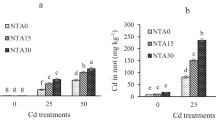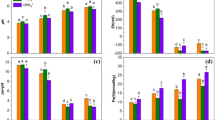Abstract
Heavy metal pollution is a serious problem in wetland ecosystems, and the toxicity of heavy metals affects microorganisms, thus influencing the biogeochemical process of nitrogen (N). To investigate the effects of heavy metal cadmium (Cd) pollution on N mineralization in urban constructed wetland soils of the Pearl River Delta, a 40-day aerobic incubation experiment was conducted under three Cd addition treatments [no Cd addition (control), low Cd addition (LCA) and high Cd addition (HCA)]. The results showed that compared with the control, the LCA treatment enhanced the soil N mineralization rate (RM), while the HCA treatment inhibited RM, with the average RM values in the control treatment of 0.40 mg kg−1 day−1, LCA treatments (0.66 mg kg−1 day−1), and HCA treatments (0.21 mg kg−1 day−1). The average ammonification rate values in the LCA treatments (− 3.15 to 2.25 mg kg−1 day−1) were higher than those in the HCA treatments (− 2.39 to 0.74 mg kg−1 day−1) and the control treatment (− 0.68 to 0.90 mg kg−1 day−1) (P < 0.05). However, the nitrification values in the HCA treatments (− 0.37 to 3.36 mg kg−1 day−1) were higher than those in the LCA treatments (0.42–1.93 mg kg−1 day−1) and the control treatment (0.20–1.45 mg kg−1 day−1) (P < 0.05). The net N mineralization accumulation generally increased over the entire incubation time in different Cd addition treatments. The percentage of NH4+–N to total inorganic N showed a decrease, while an increase was observed for NO3−–N over the incubation time. The urease activities were significantly inhibited in the LCA and HCA treatments and showed a “decreasing before increasing” trend. The abundance of ammonia oxidizing archaea (AOA) was higher in the two Cd addition treatments than the control treatment, and higher in the LCA treatments than in the HCA treatment. AOA was the dominant microorganism in the ammonia oxidation process of N mineralization in constructed wetland soils. The findings of this work indicate that Cd addition has a profound effect on the balance of N mineralization and may further impact the plant productivity and water quality of constructed wetlands.





Similar content being viewed by others
References
Anja, S., Anja, P., Pierre, O., Sabine, Z. G., Susanne, H., Nicolas, R., et al. (2012). The genome of the ammonia-oxidizing Candidatus Nitrososphaera gargensis: Insights into metabolic versatility and environmental adaptations. Environmental Microbiology, 14, 3122–3145.
Atlas, R. M. (1984). Use of microbial diversity measurements to assess environmental stress. In M. J. Klug & C. A. Reddy (Eds.), Current perspectives in microbial ecology (pp. 540–545). Washington: American Society for Microbiology.
Bai, J., Gao, H., Xiao, R., Wang, J., & Huang, C. (2012). A review of soil nitrogen mineralization as affected by water and salt in coastal wetlands: Issues and methods. Clean – Soil Air Water, 40, 1099–1105.
Bewley, R. J. F., & Stotzky, G. (1983). Effects of cadmium and simulated acid rain on ammonification and nitrification in soil. Archives of Environmental Contamination & Toxicology, 12, 285–291.
Chapin III, F. S., Matson, P. A., & Vitousek, P. (2011). Principles of terrestrial ecosystem ecology. New York: Springer.
Chen, Y., Sun, T.-T., Qian, H.-Y., Fan, J.-B., He, Y.-Q., & Sun, B. (2016). Nitrogen mineralization as a result of phosphorus supplementation in long-term phosphate deficient soil. Applied Soil Ecology, 106, 24–32.
Chen, Y. X., Wang, X. K., Lin, Q. I., Tian, G. M., & Yang, Y. (2001). Effects of heavy metals on ammonification, nitrification and denitrification in maize rhizosphere. Pedosphere, 11, 115–122.
Craft, C. (2008). Biogeochemistry of wetlands: Science and applications. Soil Science Society of America Journal, 73, 1779.
Dar, G. H. (1997). Impact of lead and sewage sludge on soil microbial biomass and carbon and nitrogen mineralization. Bulletin of Environmental Contamination & Toxicology, 58, 234–240.
Dušek, L. (1995). The effect of cadmium on the activity of nitrifying populations in two different grassland soils. Plant & Soil, 177, 43–53.
Gao, H., Bai, J., He, X., Zhao, Q., Lu, Q., & Wang, J. (2014). High temperature and salinity enhance soil nitrogen mineralization in a tidal freshwater marsh. PLoS ONE, 9(4), e95011.
Gao, J., Fan, X., Wu, G., Li, T., & Pan, K. (2015). Changes of abundance and diversity of ammonia-oxidizing archaea (AOA) and bacteria (AOB) in three nitrifying bioreactors with different ammonia concentrations. Desalination & Water Treatment, 57, 1–13.
Giller, K. E., Witter, E., & Mcgrath, S. P. (1998). Toxicity of heavy metals to microorganisms and microbial processes in agricultural soils: A review. Soil Biology and Biochemistry, 30(10–11), 1389–1414.
Giller, K. E., Witter, E., & McGrath, S. P. (2009). Heavy metals and soil microbes. Soil Biology & Biochemistry, 41, 2031–2037.
Hassen, A., Jedidi, N., Cleemput, O. V., Cherif, M., M'Hiri, A., & Boudabous, A. (1998). Mineralization of nitrogen in a clayey loamy soil amended with organic wastes enriched with Zn, Cu and Cd. Bioresource Technology, 64, 39–45.
Huang, L., Bai, J., Wen, X., Zhang, G., Zhang, C., Cui, B., et al. (2020). Microbial resistance and resilience in response to environmental changes under the higher intensity of human activities than global average level. Global Change Biology. https://doi.org/10.1111/gcb.14995.
Jia, J., Bai, J., Gao, H., Wang, W., Yin, S., Wang, D., et al. (2019). Effects of salinity and moisture on sediment net nitrogen mineralization in salt marshes of a Chinese estuary. Chemosphere, 228, 174–182.
Jia, J., Bai, J., Gao, H., Wen, X., Zhang, G., Cui, B., et al. (2017). In situ soil net nitrogen mineralization in coastal salt marshes (Suaeda salsa) with different flooding periods in a Chinese estuary. Ecological Indicators, 73, 559–565.
Kanat, G., Ikizoglu, B., Erguven, G. O., & Akgun, B. (2018). Determination of pollution and heavy metal fractions in golden horn sediment sludge (Istanbul, Turkey). Polish Journal of Environmental Studies, 27(6), 2605–2611.
Leung, H. M., Duzgoren-Aydin, N. S., Au, C. K., Krupanidhi, S., Fung, K. Y., Cheung, K. C., et al. (2017). Monitoring and assessment of heavy metal contamination in a constructed wetland in Shaoguan (Guangdong Province, China): Bioaccumulation of Pb, Zn, Cu and Cd in aquatic and terrestrial components. Environmental Science & Pollution Research, 24(10), 9079–9088.
Li, Q. S., Wu, Z., Chu, B., Zhang, N., Cai, S., & Fang, J. (2007). Heavy metals in coastal wetland sediments of the Pearl River Estuary, China. Environmental Pollution, 149, 158–164.
Mishra, S., Di, H. J., Cameron, K. C., Monaghan, R., & Carran, A. (2005). Gross nitrogen mineralisation rates in pastural soils and their relationships with organic nitrogen fractions, microbial biomass and protease activity under glasshouse conditions. Biology & Fertility of Soils, 42, 45–53.
Nelson, D. W., & Sommers, L. E. (1982). Total carbon, organic carbon, and organic matter. In A. L. Page, R. H. Miller, & D. R. Keeney (Eds.), Methods of soil analysis (pp. 539–579). Wisconsin: American Society of Agronomy.
Nwuche, C. O., & Ugoji, E. O. (2008). Effects of heavy metal pollution on the soil microbial activity. International Journal of Environmental Science & Technology, 5, 409–414.
Raiesi, F., Razmkhah, M., & Kiani, S. (2018). Salinity stress accelerates the effect of cadmium toxicity on soil N dynamics and cycling: Does joint effect of these stresses matter? Ecotoxicology and Environmental Safety, 153, 160–167.
Rother, J. A., Millbank, J. W., & Thornton, I. (1982). Effects of heavy-metal additions on ammonification and nitrification in soils contaminated with cadmium, lead and zinc. Plant & Soil, 69, 239–258.
Sakadevan, K., Zheng, H., & Bavor, H. J. (1999). Impact of heavy metals on denitrification in surface wetland sediments receiving wastewater. Water Science & Technology, 40, 349–355.
Sardans, J., Peñuelas, J., & Estiarte, M. (2008). Changes in soil enzymes related to C and N cycle and in soil C and N content under prolonged warming and drought in a Mediterranean shrubland. Applied Soil Ecology, 39, 223–235.
Schinner, F., Öhlinger, R., Kandeler, D. E., & Margesin, R. (1996). Methods in soil biology. Berlin: Springer.
Tejada, M. (2009). Application of different organic wastes in a soil polluted by cadmium: Effects on soil biological properties. Geoderma, 153, 254–268.
Vasileiadis, S., Coppolecchia, D., Puglisi, E., Balloi, A., Mapelli, F., Hamon, R. E., et al. (2012). Response of ammonia oxidizing bacteria and archaea to acute zinc stress and different moisture regimes in soil. Microbial Ecology, 64, 1028–1037.
Vig, K., Megharaj, M., & Sethunathan, N. (2004). Bioavailability and toxicity of cadmium to microorganisms and their activities in soil: A review. Advances in Environmental Research, 8, 121–135.
Vymazal, J. (2007). Removal of nutrients in various types of constructed wetlands. Science of the Total Environment, 380, 48.
Wang, P., Di, H. J., Cameron, K. C., Tan, Q., Podolyan, A., Zhao, X., et al. (2017). The response of ammonia-oxidizing microorganisms to trace metals and urine in two grassland soils in New Zealand. Environmental Science & Pollution Research, 24, 2476–2483.
Willm, M. H., Berube, P. M., Hidetoshi, U., Torre, J. R., La, De, & Stahl, D. A. (2009). Ammonia oxidation kinetics determine niche separation of nitrifying archaea and bacteria. Nature, 461, 976–979.
Wyszkowska, J., Borowik, A., Kucharski, M., & Kucharski, J. (2013). Effect of cadmium, copper and zinc on plants, soil microorganisms and soil enzymes. Journal of Elementology, 18, 769–796.
Xiao, R., Bai, J., Huang, L., Zhang, H., Cui, B., & Liu, X. (2013). Distribution and pollution, toxicity and risk assessment of heavy metals in sediments from urban and rural rivers of the Pearl River delta in southern China. Ecotoxicology, 22, 1564–1575.
Yan, J., Quan, G., & Cheng, D. (2013). Effects of the combined pollution of lead and cadmium on soil urease activity and nitrification. Procedia Environmental Sciences, 18, 78–83.
Yang, B. S., He, F., Chen, Q. L., & Wang, H. (2015). Toxicological effects of Cd pollution on soil urease activity. Paris: Atlantis Press.
Ye, Y., Chen, Y. X., Tian, G. M., & Zhang, Z. J. (2007). Dynamics of microbial activity related to N cycling in Cd-contaminated soil during growth of soybean. Pedosphere, 17, 383–388.
Zaman, M., Saggar, S., Blennerhassett, J. D., & Singh, J. (2009). Effect of urease and nitrification inhibitors on N transformation, gaseous emissions of ammonia and nitrous oxide, pasture yield and N uptake in grazed pasture system. Soil Biology & Biochemistry, 41, 1270–1280.
Zhang, Y., Xin, K. E., Guan, L. Z., & Yan, L. (2010). Effect of cadmium on kinetic characteristics of soil urease. Journal of Shenyang Agricultural University, 41, 299–303.
Zheng, L., Zhang, M., Xiao, R., Chen, J., & Yu, F. (2016). Impact of salinity and Pb on enzyme activities of a saline soil from the Yellow River delta: A microcosm study. Physics & Chemistry of the Earth Parts A/b/c, 97, 77–87.
Acknowledgements
This study was financially supported by the National Key R&D Program of China (No. 2017YFC0505906) and the Key Project of National Natural Science Foundation (U1901212), Project supported by the Fund for Innovative Research Group of the National Natural Science Foundation of China (No. 51721093), the Fundamental Research Funds for the Central Universities and the Interdiscipline Research Funds of Beijing Normal University.
Author information
Authors and Affiliations
Corresponding author
Additional information
Publisher's Note
Springer Nature remains neutral with regard to jurisdictional claims in published maps and institutional affiliations.
Rights and permissions
About this article
Cite this article
Bai, J., Yu, P., Wen, X. et al. Effects of cadmium addition on net nitrogen mineralization processes in the urban constructed wetland soils of a Chinese delta. Environ Geochem Health 43, 1155–1164 (2021). https://doi.org/10.1007/s10653-020-00597-0
Received:
Accepted:
Published:
Issue Date:
DOI: https://doi.org/10.1007/s10653-020-00597-0




